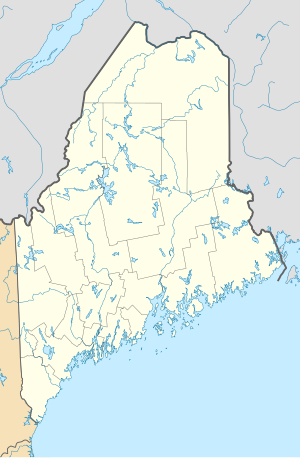
A sailboat or sailing boat is a boat propelled partly or entirely by sails and is smaller than a sailing ship. Distinctions in what constitutes a sailing boat and ship vary by region and maritime culture.

A sailing vessel's rig is its arrangement of masts, sails and rigging. Examples include a schooner rig, cutter rig, junk rig, etc. A rig may be broadly categorized as "fore-and-aft", "square", or a combination of both. Within the fore-and-aft category there is a variety of triangular and quadrilateral sail shapes. Spars or battens may be used to help shape a given kind of sail. Each rig may be described with a sail plan—formally, a drawing of a vessel, viewed from the side.

A ketch is a two-masted sailboat whose mainmast is taller than the mizzen mast, and whose mizzen mast is stepped forward of the rudder post. The mizzen mast stepped forward of the rudder post is what distinguishes the ketch from a yawl, which has its mizzen mast stepped aft of its rudder post. In the 19th and 20th centuries, ketch rigs were often employed on larger yachts and working watercraft, but ketches are also used as smaller working watercraft as short as 15 feet, or as small cruising boats, such as Bill Hanna's Tahiti ketches or L. Francis Herreshoff's Rozinante and H-28.
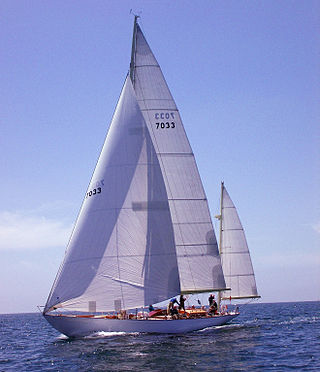
A yawl is a type of boat. The term has several meanings. It can apply to the rig, to the hull type or to the use which the vessel is put.
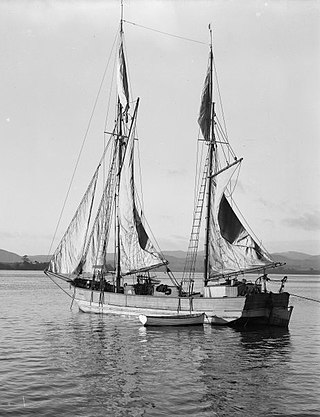
A scow is a smaller type of barge. Some scows are rigged as sailing scows. In the 19th and early 20th centuries, scows carried cargo in coastal waters and inland waterways, having an advantage for navigating shallow water or small harbours. Scows were in common use in the American Great Lakes and other parts of the U.S., Canada, southern England, and New Zealand. In modern times their main purpose is for recreation and racing; there are also garbage scows for aquatic transport of refuse.

Gaff rig is a sailing rig in which the sail is four-cornered, fore-and-aft rigged, controlled at its peak and, usually, its entire head by a spar (pole) called the gaff. Because of the size and shape of the sail, a gaff rig will have running backstays rather than permanent backstays.

Adventuress is a 133-foot (41 m) gaff-rigged schooner launched in 1913 in East Boothbay, Maine. She has since been restored, and is listed as a National Historic Landmark. She is one of two surviving San Francisco bar pilot schooners.

Thomas W. Lawson was a seven-masted, steel-hulled schooner built for the Pacific trade, but used primarily to haul coal and oil along the East Coast of the United States. Named for copper baron Thomas W. Lawson, a Boston millionaire, stock-broker, book author, and president of the Boston Bay State Gas Co., she was launched in 1902 as the largest schooner and largest sailing vessel without an auxiliary engine ever built.

The schooner J. & E. Riggin, a National Historic Landmark, was built on the Maurice River in Dorchester, New Jersey in 1927. She is one of a small number of surviving two-masted schooners, once one of the most common sailing ships in North American waters. Now based in Rockland, Maine, she serves as a "windjammer" offering sailing cruises to tourists.
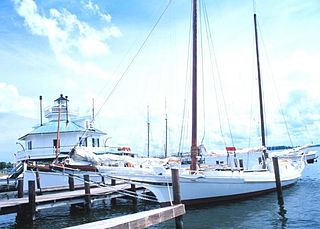
The bugeye is a type of sailboat developed in the Chesapeake Bay for oyster dredging. The predecessor of the skipjack, it was superseded by the latter as oyster harvests dropped.
The Falmouth Quay Punt was a type of working sailing vessel in the port of Falmouth, Cornwall in the 19th and early 20th century. They would be hired by merchant ships anchored in Carrick Roads – to carry stores, mail and passengers. Falmouth, with a good deep water harbour situated near the Western entrance to the English Channel, was a popular port for merchant sailing ships to call "for orders". Before the days of radio, captains would often not know which port their cargo would be destined for before they arrived in the country, and needed to collect instructions before continuing.
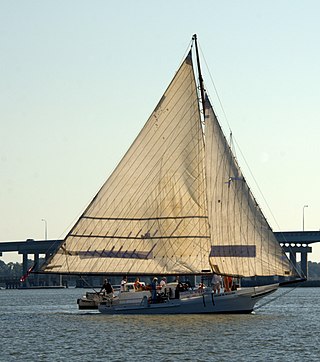
Hilda M. Willing is a relatively small Chesapeake Bay skipjack, built in 1905 at Oriole, Maryland, and declared a National Historic Landmark in 1994.

Grace Bailey, also known for many years as Mattie, is a two-masted schooner whose home port is Camden Harbor, Camden, Maine. Built in 1882 in Patchogue, New York, she is one of four surviving two-masted wooden-hulled schooners, once the most common vessel in the American coasting trade. She was one of the first ships in the fleet of historic vessels known as "Maine windjammers", which offer cruises in Penobscot Bay and the Maine coast, entering that service in 1939. She last underwent major restoration in 1989–90. She was declared a National Historic Landmark in 1992.
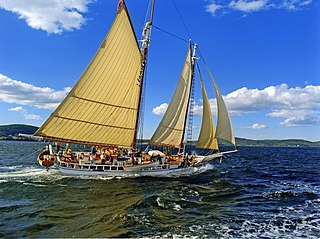
Isaac H. Evans, originally Boyd N. Sheppard, is a two-masted schooner berthed in Rockland, Maine. She is a Maine windjammer, serving the tourist trade. Built in 1886 in Mauricetown, New Jersey, she is the oldest of a small number of surviving oyster schooners, used in service of the oyster harvesting industry in the coastal waters of New Jersey. She was declared a National Historic Landmark in 1992.

Lewis R. French is a gaff-rigged topsail schooner sailing out of Camden, Maine as a "Maine windjammer" offering 3 to 6 night cruises to tourists. Built in 1871, she is the oldest known two-masted schooner in the United States, and one of a small number of this once-common form of vessel in active service. The ship was designated a US National Historic Landmark in 1992.

The Rebecca T. Ruark is a Chesapeake Bay skipjack built at Taylor's Island, Maryland. She is homeported at Tilghman Island, Maryland. Built in 1896, she is the oldest surviving skipjack in the Chesapeake Bay fleet. She was designated a National Historic Landmark in 2003.

Literally, the word pinisi refers to a type of rigging of Indonesian sailing vessels. A pinisi carries seven to eight sails on two masts, arranged like a gaff-ketch with what is called 'standing gaffs' — i.e., unlike most Western ships using such a rig, the two main sails are not opened by raising the spars they are attached to, but the sails are 'pulled out' like curtains along the gaffs which are fixed at around the centre of the masts.

The Rob Roy 23 is an American trailerable sailboat, that was designed by Edward S. Brewer and first built in 1980. The design is out of production.
This glossary of nautical terms is an alphabetical listing of terms and expressions connected with ships, shipping, seamanship and navigation on water. Some remain current, while many date from the 17th to 19th centuries. The word nautical derives from the Latin nauticus, from Greek nautikos, from nautēs: "sailor", from naus: "ship".

A sail plan is a drawing of a sailing craft, viewed from the side, depicting its sails, the spars that carry them and some of the rigging that supports the rig. By extension, "sail plan" describes the arrangement of sails on a craft. A sailing craft may be waterborne, an iceboat, or a sail-powered land vehicle.

